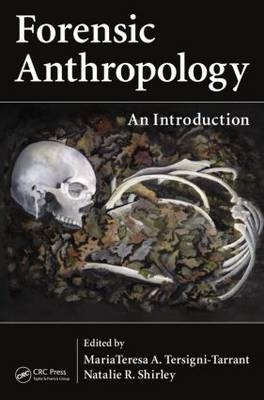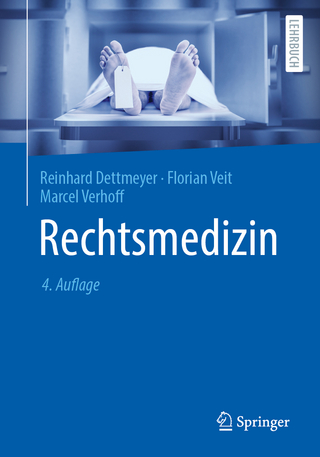
Forensic Anthropology
Crc Press Inc (Verlag)
978-1-4398-1646-2 (ISBN)
- Titel erscheint in neuer Auflage
- Artikel merken
The field of forensic anthropology has evolved dramatically in the past 40 years, as technological advances have led to new research initiatives and extended applications. This robust, dynamic, and international field has grown to include interdisciplinary research, continually improving methodology, and globalization of training. Reflecting the diverse nature of the science from the experts who have shaped it, Forensic Anthropology: An Introduction incorporates standard practices in addition to cutting-edge approaches in a user-friendly format, making it an ideal introductory-level text.
The book begins with a historical overview of forensic anthropology and then presents the background and methodology of each specialty area. Designed for readers without previous theory-based or practical physical anthropology course experience, each chapter gives a detailed history and explanation of a particular methodology. Presenting topics within their areas of accomplishment and expertise, the authors include up-to-date analytical techniques and provide examples of these applications in typical casework.
Through the book’s accessible style of presentation, readers will gain an in-depth understanding of the history, methods, theory, and future direction of forensic anthropology. Suitable for undergraduate or master’s level students, educators and professionals will also find the currency of information and the high-quality photos and illustrations useful in their practice.
MariaTeresa A. Tersigni-Tarrant, Ph.D., is a forensic anthropologist at the Joint POW/MIA Accounting Command’s Central Identification Laboratory and is a fellow of the American Academy of Forensic Sciences. She received her bachelor’s degrees in microbiology and anthropology from Michigan State University in 2000 as a student of Dr. Norman J. Sauer, Ph.D., D-ABFA. She received her M.A. (2002) and Ph.D. (2005) in physical anthropology from the University of Tennessee in Knoxville as a student of Dr. Murray Marks, Ph.D., D-ABFA. Dr. Tersigni-Tarrant was awarded a postdoctoral fellowship in 2005 at the Joint POW/MIA Accounting Command’s Central Identification Laboratory. During this fellowship, she was instrumental in establishing standard operating procedures for the histological analysis of human remains for the purpose of identifying missing armed service members. Until June 2012, Dr. Tersigni-Tarrant was the consulting forensic anthropologist for the Georgia Bureau of Investigation. Her research interests include bone biology, human and nonhuman histology, child abuse—specifically patterned fractures and timing of healing—human decomposition research, bone pathology, and developmental anatomy. Natalie R. Shirley, Ph.D., is an assistant professor of anatomy at LMU DeBusk College of Osteopathic Medicine and an adjunct faculty member at the University of Tennessee Anthropology Department. She received her B.A. (1998) and M.A. (2001) in anthropology from Louisiana State University and her Ph.D. (2009) from the University of Tennessee in Knoxville as a student of Dr. Richard Jantz, Director Emeritus of the Forensic Anthropology Center. Her postdoctoral research (Improving Sex Estimation from Crania Using 3-Dimensional CT Scans) was sponsored by the National Institute of Justice. Dr. Shirley’s research interests include skeletal maturation in modern populations, age and sex estimation, secular change, and skeletal trauma. She is a member of the American Academy of Forensic Sciences, where she was awarded the Emerging Forensic Scientist Award (2007) for her research on secular change in skeletal maturation. Dr. Shirley also works as an instructor and researcher for the U.S. Department of Justice’s International Criminal Investigative Training Assistance Program’s initiative in Colombia. She was recently featured as the forensic anthropologist on the National Geographic series The Great American Manhunt.
Brief History of Forensic Anthropology; MariaTeresa A. Tersigni-Tarrant and Natalie R. Shirley
Joint POW/MIA Accounting Command/Central Identification Laboratory (JPAC/CIL) History; Thomas D. Holland and MariaTeresa A. Tersigni-Tarrant
Forensic Anthropology Today; MariaTeresa A. Tersigni-Tarrant and Natalie R. Shirley
Human Osteology; MariaTeresa A. Tersigni-Tarrant, and Natalie R. Shirley
Human Odontology and the Dentition in Forensic Anthropology; Debra Prince Zinni and Kate M. Crowley
Crime Scene Methodology; Denise To
Processing and Inventory of Remains; Lee Meadows Jantz
Determining the Sex of Unknown Human Skeletal Remains; Gregory E. Berg
Age Estimation Methods; Natalie R. Shirley, Alice E. Fazlollah, and MariaTeresa A. Tersigni-Tarrant
Age Estimation in Modern Forensic Anthropology; Bridget F.B. Algee-Hewitt
Why Do Forensic Anthropologists Estimate Ancestry; and Why Is It So Controversial? M. Katherine Spradley and Katherine Weisensee
Stature Estimation; Natalie R. Shirley
Introduction to Fordisc 3; Richard L. Jantz and Stephen D. Ousley
Low-Velocity Trauma; Hugh E. Berryman, Natalie R. Shirley, and Alicja K. Lanfear
Basic Gunshot Trauma Interpretation in Forensic Anthropology; Hugh E. Berryman, Natalie R. Shirley, and Alicja K. Lanfear Taphonomy of Fire; Joanne Bennett Devlin and Nicholas P. Herrmann
Taphonomic Processes: Animal Scavenging; James T. Pokines and MariaTeresa A. Tersigni-Tarrant
Time since Death Estimation and Bone Weathering: The Postmortem Interval; Rebecca J. Wilson-Taylor
Taphonomic Processes: Analysis of Fragmentary Remains;
MariaTeresa A. Tersigni-Tarrant
Methods of Personal Identification; Angi M. Christensen and Bruce E. Anderson
Forensic Anthropology: A Human Rights Approach; Erin H. Kimmerle
Forensic Anthropology in Mass Disasters; Paul S. Sledzik
Index
| Zusatzinfo | 17 Tables, black and white; 231 Illustrations, color; 231 Illustrations, black and white |
|---|---|
| Verlagsort | Bosa Roca |
| Sprache | englisch |
| Maße | 178 x 254 mm |
| Gewicht | 1179 g |
| Themenwelt | Geisteswissenschaften ► Archäologie |
| Studium ► 2. Studienabschnitt (Klinik) ► Rechtsmedizin | |
| Recht / Steuern ► EU / Internationales Recht | |
| Recht / Steuern ► Strafrecht ► Kriminologie | |
| Sozialwissenschaften ► Ethnologie | |
| Sozialwissenschaften ► Soziologie | |
| ISBN-10 | 1-4398-1646-8 / 1439816468 |
| ISBN-13 | 978-1-4398-1646-2 / 9781439816462 |
| Zustand | Neuware |
| Informationen gemäß Produktsicherheitsverordnung (GPSR) | |
| Haben Sie eine Frage zum Produkt? |
aus dem Bereich



